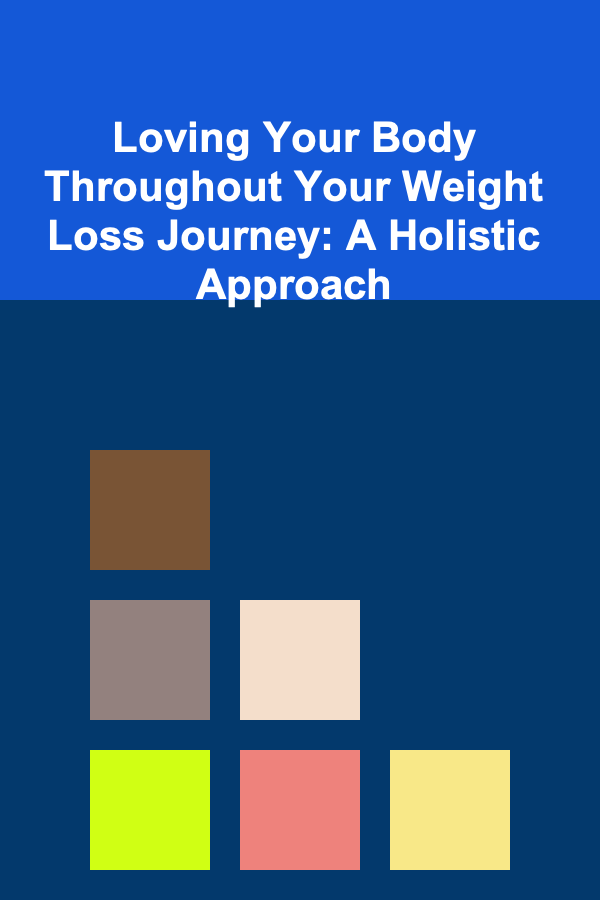
How to Structure a Yoga To-Do List for Back Pain Relief
ebook include PDF & Audio bundle (Micro Guide)
$12.99$10.99
Limited Time Offer! Order within the next:
Not available at this time

Back pain is a widespread condition that affects millions of people around the world. It can range from mild discomfort to severe pain, limiting mobility and daily activities. While there are various methods to alleviate back pain, yoga has proven to be one of the most effective and holistic approaches. Through gentle stretches and mindful movements, yoga can improve flexibility, strength, and alignment, helping to relieve and prevent back pain.
Creating a yoga to-do list specifically for back pain relief involves selecting poses and sequences that target key areas of the body responsible for back tension. This includes the spine, hips, hamstrings, and shoulders. In this article, we'll explore how to structure an effective yoga routine to help relieve back pain and promote long-term spinal health.
Why Yoga for Back Pain?
Yoga is a powerful tool for back pain relief for several reasons:
- Improves Flexibility: Tight muscles, especially in the lower back, hips, and hamstrings, can contribute to back pain. Regular yoga practice helps to stretch and lengthen these muscles, reducing stiffness and discomfort.
- Strengthens Core Muscles: A strong core supports the spine and reduces strain on the back. Yoga focuses on building strength in the abdominal and back muscles, which can stabilize the spine and prevent future pain.
- Promotes Postural Alignment: Poor posture is a significant contributor to back pain. Yoga encourages awareness of alignment, helping to improve posture and reduce unnecessary pressure on the spine.
- Enhances Body Awareness: Yoga cultivates mindfulness and awareness of the body, enabling individuals to notice imbalances or misalignments that may be causing discomfort.
- Reduces Stress: Chronic stress can exacerbate muscle tension and contribute to back pain. Yoga's emphasis on relaxation techniques, such as deep breathing and meditation, can help to reduce stress and calm the nervous system.
With regular practice, yoga can alleviate the symptoms of back pain, improve overall flexibility and strength, and reduce the risk of future injuries. Below is a guide to structuring a yoga to-do list designed specifically for back pain relief.
Start with a Gentle Warm-Up
Before diving into more challenging poses, it's essential to warm up the body. A gentle warm-up increases blood flow to the muscles, reduces stiffness, and prepares the body for deeper stretches. Begin with some simple movements to activate the spine and hips.
Recommended Warm-Up Poses:
- Cat-Cow Pose (Marjaryasana-Bitilasana): This dynamic stretch promotes flexibility in the spine and helps to release tension in the back. Start on your hands and knees, inhale to arch the back (cow), and exhale to round the spine (cat). Repeat for 5-10 rounds.
- Child's Pose (Balasana): This resting pose helps to stretch the lower back and hips. Sit on your heels and extend your arms forward, lowering your chest to the floor. Hold for 30 seconds to 1 minute, breathing deeply.
- Downward-Facing Dog (Adho Mukha Svanasana): This pose stretches the entire back, hamstrings, and calves. Start on your hands and knees, lift your hips towards the ceiling, and straighten your legs. Hold for 30 seconds.
These warm-up poses will help to ease into the practice, reducing the risk of injury and promoting a greater range of motion in the back.
Focus on Core Strengthening Poses
Building core strength is key to preventing and alleviating back pain. A strong core supports the spine, reduces strain on the lower back, and improves posture. Incorporate poses that activate the abdominals, obliques, and lower back muscles.
Recommended Core Strengthening Poses:
- Plank Pose (Phalakasana): Plank strengthens the entire core and helps stabilize the spine. Start in a push-up position with your hands directly under your shoulders and your body in a straight line. Hold for 30 seconds to 1 minute.
- Boat Pose (Navasana): This pose targets the deep core muscles. Sit on the floor with your knees bent and feet flat. Lean back slightly, lift your legs to a 45-degree angle, and extend your arms forward. Hold for 20-30 seconds.
- Bridge Pose (Setu Bandhasana): Bridge pose strengthens the glutes, lower back, and hamstrings. Lie on your back with your knees bent and feet flat on the floor. Lift your hips towards the ceiling, squeezing your glutes. Hold for 30 seconds.
These poses target the core muscles, which are crucial for supporting the lower back and maintaining good posture.
Target the Hips and Hamstrings
Tightness in the hips and hamstrings can contribute to back pain, particularly in the lower back. Stretching and opening the hip flexors and hamstrings can relieve tension and improve flexibility. These areas often become tight due to prolonged sitting or poor posture, both of which can lead to back pain.
Recommended Hip and Hamstring Stretches:
- Pigeon Pose (Eka Pada Rajakapotasana): This deep hip opener targets the hip flexors and glutes. From a tabletop position, bring your right knee towards your right wrist and extend your left leg straight back behind you. Hold for 30 seconds and repeat on the other side.
- Forward Fold (Uttanasana): This pose stretches the hamstrings and lower back. Stand with your feet hip-width apart, then fold forward at the hips, reaching towards the ground. Hold for 30 seconds to 1 minute.
- Lizard Pose (Utthan Pristhasana): This stretch opens the hips and targets the hip flexors. From a plank position, step your right foot forward, keeping your hands on the floor. Lower your hips towards the ground and hold for 30 seconds.
These stretches will help release tension in the hips and hamstrings, which can alleviate pressure on the lower back.
Focus on Spinal Flexion and Extension
Maintaining a healthy spine is crucial for back pain relief. Incorporate movements that promote spinal flexibility and mobility. These poses encourage gentle stretching and strengthening of the spinal muscles, which can improve posture and alleviate pain.
Recommended Spinal Flexion and Extension Poses:
- Cobra Pose (Bhujangasana): Cobra pose strengthens the lower back and stretches the chest and abdomen. Lie on your stomach, place your hands under your shoulders, and press into your palms to lift your chest off the ground. Hold for 20-30 seconds.
- Seated Forward Fold (Paschimottanasana): This forward fold stretches the spine, hamstrings, and lower back. Sit with your legs extended straight in front of you, and fold forward at the hips, reaching for your feet. Hold for 30 seconds to 1 minute.
- Sphinx Pose (Salamba Bhujangasana): Sphinx pose is a gentle backbend that helps to strengthen the lower back and improve spinal extension. Lie on your stomach with your forearms on the ground, and lift your chest upwards, keeping your elbows directly under your shoulders. Hold for 30 seconds.
These poses focus on both spinal flexion (forward bending) and extension (backbending), helping to improve flexibility and strength in the spine.
End with Relaxation and Restorative Poses
After your yoga practice, it's important to cool down and allow your body to relax. Restorative poses help to release any remaining tension and promote deep relaxation. These poses are particularly beneficial for relieving back pain, as they encourage the body to rest and heal.
Recommended Restorative Poses:
- Savasana (Corpse Pose): Savasana is the final relaxation pose, helping to calm the nervous system and reduce stress. Lie on your back with your legs extended and arms by your sides. Close your eyes and focus on your breath. Stay for 5-10 minutes.
- Legs Up the Wall (Viparita Karani): This gentle inversion helps to relieve tension in the lower back and legs. Sit close to a wall, then lie back and extend your legs up the wall, allowing your lower back to relax. Hold for 5-10 minutes.
- Reclining Bound Angle Pose (Supta Baddha Konasana): This restorative pose opens the hips and relaxes the back. Lie on your back, bring the soles of your feet together, and allow your knees to fall open. Place your hands on your belly and focus on deep breathing. Hold for 5-10 minutes.
These restorative poses help the body relax, recover, and reset after the physical exertion of the yoga practice. They also promote a sense of well-being, which is important for managing and alleviating back pain.
Conclusion
A structured yoga to-do list for back pain relief should incorporate poses that target flexibility, strength, and alignment. The sequence outlined above includes key poses that address the core, hips, hamstrings, spine, and relaxation, all of which are essential for maintaining a healthy back.
Remember that yoga is a practice that requires consistency and patience. Start with gentle, restorative poses and gradually increase the intensity as your body becomes stronger and more flexible. Always listen to your body, and avoid pushing yourself into pain. If you have severe back pain or a medical condition, it's important to consult with a healthcare professional before starting a yoga practice.
With regular practice, yoga can be an incredibly effective tool for relieving back pain, improving posture, and enhancing overall well-being.

How to Clean Your Home for the Spring Season
Read More
How to Create a Checklist for Developing a Project Timeline
Read More
How to Protect Your Finances from Inflation and Economic Downturns
Read More
Transforming Businesses with IT Solutions: A Practical Guide for IT Consultants
Read More
Why Organizing Your Cleaning Supplies Can Make Chores Easier
Read More
Loving Your Body Throughout Your Weight Loss Journey: A Holistic Approach
Read MoreOther Products

How to Clean Your Home for the Spring Season
Read More
How to Create a Checklist for Developing a Project Timeline
Read More
How to Protect Your Finances from Inflation and Economic Downturns
Read More
Transforming Businesses with IT Solutions: A Practical Guide for IT Consultants
Read More
Why Organizing Your Cleaning Supplies Can Make Chores Easier
Read More